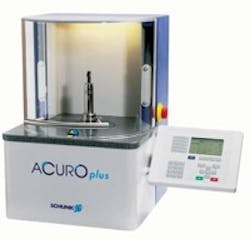Schunk's Acuro Plus has minimal space and energy requirements.
Balanced tool/toolholder combinations are indispensible for high quality surface finishes and cutting results. Here are new products that make balancing easier.
A new balancing machine from Schunk Inc.(www.schunk.com) called Acuro Plus, has minimal requirements with regard to space and energy. The balancer requires a conventional 110-V power connection and 87-psi compressed air.
Within seconds, a complete toolholder/tool system is balanced in one plane or, for long systems, also in two planes. An adapter system with automatic clamping provides the same pulling forces as a machine spindle. Basic data input is done via a menu-driven system. This includes the desired balancing tolerances in balance quality (optionally G or Q) and the specific density of material.
Balancing operations of toolholders with a maximum weight to 33 lbs. and a maximum length to 13.5 in. (342.9 mm) can be done at speeds of 300 rpm to 1,100 rpm. Dimensional balance accuracy is less than 1 gram millimeter. The system can also balance grinding wheels and other workpieces with a maximum diameters of 13 in.
A tool data administration on the machine stores as many as 1,000 tools and tool parameters. Depending on the toolholder balancing, a user can choose between the measuring methods index measuring or spindle compensation.
At the end of a measuring operation, the position of the unbalance is shown on the operating screen. Also, the unbalance can be shown directly on the tool by a red laser light. To compensate the determined unbalance, the operator has options including removing material by drilling or milling. For this option, the best position for material removal is calculated by a software algorithm calculating the position of the balancing bore (size of bore diameter and depth). Another option allows for the use of balance rings, balancing weights or screws to compensate for the imbalance. During this operation, the operator receives the exact position or screw-in depth required.
Rego-Fix's BMT 200 balancing machine is mobile and user friendly.
Rego-Fix said fine adjustment of its balancing rings makes balancing easier than with fixed weights.
Rego-Fix (www.regofix.com)said its BMT 200 balancing machine combines Swiss precision, extensive capability and ease of use. These compact units weigh less than 90 lbs. and allow balancing of almost any toolholder taper style or size. These machines can be used immediately on a stable work surface. No special foundation is required.
The balancer features a new spindle design, called soft-bearing technology, that the company said makes the machine lighter and more compact than other machines.
The machine measures vibrations, where other machines measure the force. The soft-bearing design technology permits different calibration for each tool set-up, allowing the operator to arrange the machine independently for various tool types. The balancing machine works well with both small or large tooling when speed increases or decreases and a number of sensor readings is required.
The BMT 200 uses a user-friendly touchscreen and offers all standard balancing methods in its basic configuration, including gram, angular, drilling radial, drilling axial, milling and fixed positioning. The company said these methods allow for fast and easy set up of the tool database.
Rego-Fix has also introduced a balancing-ring system that allows standard toolholders to be upgraded to balanceable systems at any time. Without the use of tools or weighted balls, the system balances a toolholder and assembly at up to 42,000 rpm at any G-rating. Additionally, its rings can rotate a full 360 degrees for infinitely adjustable weight distribution.
The company said its balancing-ring system is compatible with most balancing machines on the market, and is a cost-effective solution for users seeking extended tool and spindle bearing life, improved surface finish and increased chip load.
